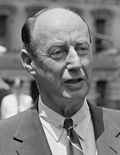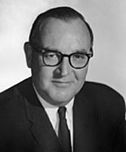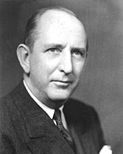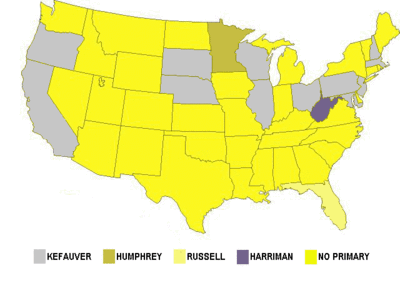- Democratic Party (United States) presidential primaries, 1952
-
Democratic Presidential Primaries, 1952 
1948 ← 1952 → 1956 


Nominee Adlai Stevenson Pat Brown Richard Russell Jr. Party Democratic Democratic Democratic Home state Illinois California Georgia States carried 12 0 1 Popular vote 3,169,448 485,578 371,179 Percentage 64.56% 9.89% 7.56%
President before election
Harry Truman
Democratic presidential candidate-elect
Adlai Stevenson
The 1952 Democratic presidential primaries were the selection process by which voters of the Democratic Party chose its nominee for President of the United States in the 1952 U.S. presidential election. Governor of Illinois Adlai Stevenson was selected as the nominee through a series of primary elections and caucuses culminating in the 1952 Democratic National Convention held from July 21 to July 26, 1952 in Chicago, Illinois.
Contents
Primary race
The expected candidate for the Democratic nomination was incumbent President Harry S. Truman. Since the newly passed 22nd Amendment did not apply to whoever was president at the time of its passage, he was eligible to run again. But Truman entered 1952 with his popularity plummeting, according to polls. The bloody and indecisive Korean War was dragging into its third year, Senator Joseph McCarthy's anti-Communist crusade was stirring public fears of an encroaching “Red Menace”, and the disclosure of widespread corruption among federal employees (including some high-level members of Truman's administration) left Truman at a low political ebb.
Truman's main opponent was populist Tennessee Senator Estes Kefauver, who had chaired a nationally televised investigation of organized crime in 1951 and was known as a crusader against crime and corruption. The Gallup poll of February 15 showed Truman's weakness: nationally Truman was the choice of only 36% of Democrats, compared with 21% for Kefauver. Among independent voters, however, Truman had only 18% while Kefauver led with 36%. In the New Hampshire primary Kefauver upset Truman, winning 19,800 votes to Truman's 15,927 and capturing all eight delegates. Kefauver graciously said that he did not consider his victory "a repudiation of Administration policies, but a desire...for new ideas and personalities." Stung by this setback, Truman soon announced that he would not seek re-election (however, Truman insisted in his memoirs that he had decided not to run for re-election well before his defeat by Kefauver).
With Truman's withdrawal, Kefauver became the front-runner for the nomination, and he won most of the primaries. However, most states still chose their delegates to the Democratic Convention via state conventions, which meant that the party bosses - especially the mayors and governors of large Northern and Midwestern states and cities - were able to choose the Democratic nominee. These bosses (including President Truman) strongly disliked Kefauver; his investigations of organized crime had revealed connections between mafia figures and many of the big-city Democratic political organizations. The party bosses thus viewed Kefauver as a maverick who could not be trusted, and they refused to support him for the nomination. Instead, with President Truman taking the lead, they began to search for other, more acceptable, candidates. However, most of the other candidates had a major weakness. Senator Richard Russell of Georgia had much Southern support, but his support of racial segregation and opposition to civil rights for Southern blacks led Northern delegates to reject him as a racist. Truman favored U.S. diplomat Averell Harriman of New York, but he had never held an elective office and was inexperienced in politics. Truman next turned to his Vice-President, Alben Barkley, but at 74 he was rejected as being too old by labor union leaders. Other minor or favorite son candidates included Oklahoma Senator Robert Kerr, Governor Paul A. Dever of Massachusetts, Senator Hubert Humphrey of Minnesota, and Senator J. William Fulbright of Arkansas.
One candidate soon emerged who seemingly had few political weaknesses: Governor Adlai Stevenson II of Illinois. The grandson of former Vice-President Adlai E. Stevenson, Stevenson came from a distinguished family in Illinois and was well-known as a gifted orator, intellectual, and political moderate. In the spring of 1952 President Truman tried to convince Stevenson to take the presidential nomination, but Stevenson refused, stating that he wanted to run for re-election as Governor of Illinois. Yet Stevenson never completely took himself out of the race, and as the convention approached many party bosses, as well as normally apolitical citizens, hoped that he could be "drafted" to run.
Democratic National Convention
Candidates gallery
-
Senator Estes Kefauver of Tennessee
-
Senator Richard Russell, Jr. of Georgia
-
Former Commerce Secretary W. Averell Harriman of New York
-
Vice President Alben W. Barkley of Kentucky
-
Senator Robert S. Kerr of Oklahoma
The 1952 Democratic National Convention was held in Chicago; the convention met in the same coliseum the Republicans had gathered in a few weeks earlier. Since the convention was being held in his home state, Governor Stevenson - who still protested that he was not a presidential candidate - was asked to give the welcoming address to the delegates. He proceeded to give a witty and stirring address that led his supporters to begin a renewed round of efforts to nominate him, despite his protests. After meeting with Jack Arvey, the "boss" of the Illinois delegation, Stevenson finally agreed to enter his name as a candidate for the nomination. The party bosses from other large Northern and Midwestern states quickly joined in support. Kefauver led on the first ballot, but had far fewer votes than necessary to win. Stevenson gradually gained strength until he was nominated on the third ballot.
The following table from Richard C. Bain and Judith H. Parris, Convention Decisions and Voting Records (Washington DC: Brookings Institution, 1973), pp. 286-292 documents the balloting. Candidates are organized according to their highest total on any single ballot, and they are listed only if they received over 20 votes on a single ballot. The 1952 Democratic convention was the last one for either party that needed more than one ballot to select a Presidential nominee.
Presidential Balloting, DNC 1952 Ballot 1 2 3 Illinois Governor Adlai Stevenson 273 324.5 617.5 Tennessee Senator Estes Kefauver 340 362.5 275.5 Georgia Senator Richard B. Russell 268 294 261 Former Secretary of Commerce and Ambassador W. Averell Harriman 123.5 121 0 Vice President Alben W. Barkley 48.5 78.5 67.5 Oklahoma Senator Robert S. Kerr 65 5.5 0 Massachusetts Governor Paul A. Dever 37.5 30.5 0.5 Minnesota Senator Hubert Humphrey 26 0 0 Arkansas Senator J. William Fulbright 22 0 0 Scattering 26.5 13.5 8 Candidates gallery
-
Senator John J. Sparkman of Alabama
-
Senator Mike Monroney of Oklahoma
-
Senator Estes Kefauver of Tennessee
-
Vice President Alben W. Barkley of Kentucky
-
Senator Richard Russell, Jr. of Georgia
The convention then chose Senator John Sparkman of Alabama, a conservative and segregationist, as Stevenson's running mate. Stevenson then delivered an eloquent acceptance speech in which he famously pledged to "talk sense to the American people."
See also
United States presidential primaries Election timelines National polling State polling Fundraising 2008Debates Democratic Party: 2008 · Republican Party: 2008Straw polls Major Events Caucuses
and primariesResults breakdown National
conventionsDemocratic Party: 1900 · 1904 · 1908 · 1912 · 1916 · 1920 · 1924 · 1928 · 1932 · 1936 · 1940 · 1944 · 1948 · 1952 · 1956 · 1960 · 1964 · 1968 · 1972 · 1976 · 1980 · 1984 · 1988 · 1992 · 1996 · 2000 · 2004 · 2008 · 2012
Republican Party: 1900 · 1904 · 1908 · 1912 · 1916 · 1920 · 1924 · 1928 · 1932 · 1936 · 1940 · 1944 · 1948 · 1952 · 1956 · 1960 · 1964 · 1968 · 1972 · 1976 · 1980 · 1984 · 1988 · 1992 · 1996 · 2000 · 2004 · 2008 · 2012Reforms United States presidential election, 1952 Republican Party
Convention · PrimariesNominee: Dwight D. Eisenhower
VP Nominee: Richard Nixon
Candidiates: Riley A. Bender · Robert Taft · Harold Stassen · Earl WarrenDemocratic Party
Convention · PrimariesNominee: Adlai Stevenson
VP Nominee: John Sparkman
Candidates: Alben W. Barkley · Paul A. Dever · W. Averell Harriman · Hubert Humphrey · Estes Kefauver · Robert S. Kerr · George Theodore Mickelson · Richard Russell, Jr.Third party and independent candidates Prohibition Party Progressive Party Socialist Labor Party Nominee: Eric HassSocialist Party of America Nominee: Darlington Hoopes
VP Nominee: Samuel H. FriedmanSocialist Workers Party Nominee: Farrell DobbsIndependents and other candidates: Other 1952 elections: House · Senate Categories:- Democratic Party (United States) presidential primaries
- United States presidential primaries, 1952
Wikimedia Foundation. 2010.









